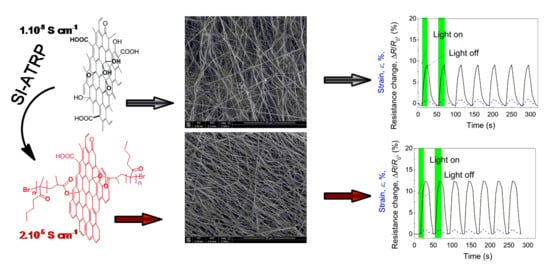Smart Non-Woven Fiber Mats with Light-Induced Sensing Capability
Abstract
1. Introduction
2. Materials and Methods
2.1. Graphene Oxide Fabrication and Immobilization of Initiator on Surface
2.2. Grafting of GO with Poly(N-Butyl Methacrylate) (PBMA) Chains
2.3. Elastomeric Composite Preparation via Electrospinning Process
2.4. General Characterization of the Synthesized Powders and Prepared Composites
2.5. Photo-Actuation and Sensing Performance
3. Results
3.1. SI-ATRP Grafting of GO with PBMA Shell Layer
3.2. Reduction of the GO Particles during SI-ATRP
3.3. Preparation of the Non-Woven Fiber Mats
3.4. Characterization of the Non-Woven Fiber Mats
3.5. Thermal Conductivity Investigation
3.6. Photo-Actuation and Sensing Capabilities
4. Conclusions
Author Contributions
Funding
Conflicts of Interest
References
- Ilcikova, M.; Mrlik, M.; Babayan, V.; Kasak, P. Graphene oxide modified by betaine moieties for improvement of electrorheological performance. RSC Adv. 2015, 5, 57820–57827. [Google Scholar] [CrossRef]
- Kutalkova, E.; Mrlik, M.; Ilcikova, M.; Osicka, J.; Sedlacik, M.; Mosnacek, J. Enhanced and tunable electrorheological capability using surface initiated atom transfer radical polymerization modification with simultaneous reduction of the graphene oxide by silyl-based polymer grafting. Nanomaterials 2019, 9, 308. [Google Scholar] [CrossRef] [PubMed]
- Mrlik, M.; Ilcikova, M.; Plachy, T.; Pavlinek, V.; Spitalsky, Z.; Mosnacek, J. Graphene oxide reduction during surface-initiated atom transfer radical polymerization of glycidyl methacrylate: Controlling electro-responsive properties. Chem. Eng. J. 2016, 283, 717–720. [Google Scholar] [CrossRef]
- Cvek, M.; Mrlik, M.; Ilcikova, M.; Mosnacek, J.; Babayan, V.; Kucekova, Z.; Humpolicek, P.; Pavlinek, V. The chemical stability and cytotoxicity of carbonyl iron particles grafted with poly(glycidyl methacrylate) and the magnetorheological activity of their suspensions. RSC Adv. 2015, 5, 72816–72824. [Google Scholar] [CrossRef]
- Cvek, M.; Mrlik, M.; Ilcikova, M.; Mosnacek, J.; Munster, L.; Pavlinek, V. Synthesis of silicone elastomers containing silyl-based polymer grafted carbonyl iron particles: an efficient way to improve magnetorheological, damping, and sensing performances. Macromolecules 2017, 50, 2189–2200. [Google Scholar] [CrossRef]
- Lubtow, M.M.; Mrlik, M.; Hahn, L.; Altmann, A.; Beudert, M.; Luhmann, T.; Luxenhofer, R. Temperature-dependent rheological and viscoelastic investigation of a poly(2-methyl-2-oxazoline)-b-poly(2-iso-butyl-2-oxazoline)-b-poly(2-meth yl-2-oxazoline)-based thermogelling hydrogel. J. Funct. Biomater. 2019, 10, 36. [Google Scholar] [CrossRef]
- Zahoranova, A.; Mrlik, M.; Tomanova, K.; Kronek, J.; Luxenhofer, R. ABA and BAB Triblock Copolymers Based on 2-Methyl-2-oxazoline and 2-n-Propyl-2-oxazoline: Synthesis and Thermoresponsive Behavior in Water. Macromol. Chem. Phys. 2017, 218, 1700031. [Google Scholar] [CrossRef]
- Antoniraj, M.G.; Kumar, C.S.; Kumari, H.L.J.; Natesan, S.; Kandasamy, R. Atrial natriuretic peptide-conjugated chitosan-hydrazone-mPEG copolymer nanoparticles as pH-responsive carriers for intracellular delivery of prednisone. Carbohydr. Polym. 2017, 157, 1677–1686. [Google Scholar] [CrossRef]
- Mrlík, M.; Špírek, M.; Al-Khori, J.; Ahmad, A.A.; Mosnaček, J.; AlMaadeed, M.A.; Kasák, P. Mussel-mimicking sulfobetaine-based copolymer with metal tunable gelation, self-healing and antibacterial capability. Arab. J. Chem. 2017. [Google Scholar] [CrossRef]
- Ilcikova, M.; Mrlik, M.; Sedlacek, T.; Doroshenko, M.; Koynov, K.; Danko, M.; Mosnacek, J. Tailoring of viscoelastic properties and light-induced actuation performance of triblock copolymer composites through surface modification of carbon nanotubes. Polymer 2015, 72, 368–377. [Google Scholar] [CrossRef]
- Osicka, J.; Ilcikova, M.; Mrlik, M.; Minarik, A.; Pavlinek, V.; Mosnacek, J. The impact of polymer grafting from a graphene oxide surface on its compatibility with a pdms matrix and the light-induced actuation of the composites. Polymers 2017, 9, 264. [Google Scholar] [CrossRef] [PubMed]
- Koerner, H.; Price, G.; Pearce, N.A.; Alexander, M.; Vaia, R.A. Remotely actuated polymer nanocomposites-stress-recovery of carbon-nanotube-filled thermoplastic elastomers. Nat. Mater. 2004, 3, 115–120. [Google Scholar] [CrossRef] [PubMed]
- Bian, K.; Liu, H.G.; Tai, G.A.; Zhu, K.J.; Xiong, K. Enhanced actuation response of nafion-based ionic polymer metal composites by doping batio3 nanoparticles. J. Phys. Chem. C 2016, 120, 12377–12384. [Google Scholar] [CrossRef]
- Wie, J.J.; Wang, D.H.; Tondiglia, V.P.; Tabiryan, N.V.; Vergara-Toloza, R.O.; Tan, L.S.; White, T.J. Photopiezoelectric composites of azobenzene-functionalized polyimides and polyvinylidene fluoride. Macromol. Rapid Commun. 2014, 35, 2050–2056. [Google Scholar] [CrossRef] [PubMed]
- Czanikova, K.; Torras, N.; Esteve, J.; Krupa, I.; Kasak, P.; Pavlova, E.; Racko, D.; Chodak, I.; Omastova, M. Nanocomposite photoactuators based on an ethylene vinyl acetate copolymer filled with carbon nanotubes. Sens. Actuator B Chem. 2013, 186, 701–710. [Google Scholar] [CrossRef]
- Yang, M.J.; Yuan, Z.K.; Liu, J.; Fang, Z.S.; Fang, L.; Yu, D.S.; Li, Q. Photoresponsive Actuators Built from Carbon-Based Soft Materials. Adv. Opt. Mater. 2019, 7, 1900069. [Google Scholar] [CrossRef]
- Punetha, V.D.; Ha, Y.M.; Kim, Y.O.; Jung, Y.C.; Cho, J.W. Interaction of photothermal graphene networks with polymer chains and laser-driven photo-actuation behavior of shape memory polyurethane/epoxy/epoxy-functionalized graphene oxide nanocomposites. Polymer 2019, 181, 121791. [Google Scholar] [CrossRef]
- Ansari, S.; Rahima, C.; Muralidharan, M.N. Photomechanical characteristics of thermally reduced graphene oxide-polydimethylsiloxane nanocomposites. Polym-Plast. Technol. Eng. 2013, 52, 1604–1610. [Google Scholar] [CrossRef]
- Osicka, J.; Mrlik, M.; Ilcikova, M.; Munster, L.; Bazant, P.; Spitalsky, Z.; Mosnacek, J. Light-induced actuation of poly(dimethylsiloxane) filled with graphene oxide grafted with poly(2-(trimethylsilyloxy)ethyl methacrylate). Polymers 2018, 10, 1059. [Google Scholar] [CrossRef]
- Sun, S.D.; Liang, S.F.; Xu, W.C.; Xu, G.F.; Wu, S. Photoresponsive polymers with multi-azobenzene groups. Polym. Chem. 2019, 10, 4389–4401. [Google Scholar] [CrossRef]
- Garcia-Amoros, J.; Stopa, G.; Stochel, G.; van Eldik, R.; Martinez, M.; Velasco, D. Activation volumes for cis-to-trans isomerisation reactions of azophenols: a clear mechanistic indicator? Phys. Chem. Chem. Phys. 2018, 20, 1286–1292. [Google Scholar] [CrossRef] [PubMed]
- Hu, Y.; Li, Z.; Lan, T.; Chen, W. Photoactuators for direct optical-to-mechanical energy conversion: from nanocomponent assembly to macroscopic deformation. Adv. Mater. 2016, 28, 10548–10556. [Google Scholar] [CrossRef] [PubMed]
- Hu, Y.; Wu, G.; Lan, T.; Zhao, J.J.; Liu, Y.; Chen, W. A graphene-based bimorph structure for design of high performance photoactuators. Adv. Mater. 2015, 27, 7867–7873. [Google Scholar] [CrossRef] [PubMed]
- Yang, Y.K.; Zhan, W.J.; Peng, R.G.; He, C.G.; Pang, X.C.; Shi, D.; Jiang, T.; Lin, Z.Q. Graphene-enabled superior and tunable photomechanical actuation in liquid crystalline elastomer nanocomposites. Adv. Mater. 2015, 27, 6376–6381. [Google Scholar] [CrossRef] [PubMed]
- Wani, O.M.; Zeng, H.; Wasylczyk, P.; Priimagi, A. programming photoresponse in liquid crystal polymer actuators with laser projector. Adv. Opt. Mater. 2018, 6, 1700949. [Google Scholar] [CrossRef]
- Rogoz, M.; Dradrach, K.; Xuan, C.; Wasylczyk, P. A millimeter-scale snail robot based on a light-powered liquid crystal elastomer continuous actuator. Macromol. Rapid Commun. 2019, 40, 1900279. [Google Scholar] [CrossRef]
- Ahir, S.V.; Terentjev, E.M. Photomechanical actuation in polymer-nanotube composites. Nat. Mater. 2005, 4, 491–495. [Google Scholar] [CrossRef]
- Loomis, J.; King, B.; Burkhead, T.; Xu, P.; Bessler, N.; Terentjev, E.; Panchapakesan, B. Graphene-nanoplatelet-based photomechanical actuators. Nanotechnology 2012, 23, 045501. [Google Scholar] [CrossRef]
- Ilcikova, M.; Mrlik, M.; Sedlacek, T.; Chorvat, D.; Krupa, I.; Slouf, M.; Koynov, K.; Mosnacek, J. Viscoelastic and photo-actuation studies of composites based on polystyrene-grafted carbon nanotubes and styrene-b-isoprene-b-styrene block copolymer. Polymer 2014, 55, 211–218. [Google Scholar] [CrossRef]
- Ilcikova, M.; Mrlik, M.; Sedlacek, T.; Slouf, M.; Zhigunov, A.; Koynov, K.; Mosnacek, J. Synthesis of photoactuating acrylic thermoplastic elastomers containing diblock copolymer-grafted carbon nanotubes. ACS Macro Lett. 2014, 3, 999–1003. [Google Scholar] [CrossRef]
- Torras, N.; Zinoviev, K.E.; Camargo, C.J.; Campo, E.M.; Campanella, H.; Esteve, J.; Marshall, J.E.; Terentjev, E.M.; Omastova, M.; Krupa, I.; et al. Tactile device based on opto-mechanical actuation of liquid crystal elastomers. Sens. Actuator A Phys. 2014, 208, 104–112. [Google Scholar] [CrossRef]
- Raturi, P.; Singh, J.P. Sunlight-driven eco-friendly smart curtain based on infrared responsive graphene oxide-polymer photoactuators. Sci. Rep. 2018, 8, 3687. [Google Scholar] [CrossRef]
- Zeng, H.; Wani, O.M.; Wasylczyk, P.; Priimagi, A. Light-driven, caterpillar-inspired miniature inching robot. Macromol. Rapid Commun. 2018, 39, 1700224. [Google Scholar] [CrossRef] [PubMed]
- Issa, A.A.; Al-Maadeed, M.A.S.; Mrlik, M.; Luyt, A.S. Electrospun PVDF graphene oxide composite fibre mats with tunable physical properties. J. Polym. Res. 2016, 23, 13. [Google Scholar] [CrossRef]
- Issa, A.A.; Al-Maadeed, M.; Luyt, A.S.; Mrlik, M.; Hassan, M.K. Investigation of the physico-mechanical properties of electrospun PVDF/cellulose (nano) fibers. J. Appl. Polym. Sci. 2016, 133, 12. [Google Scholar] [CrossRef]
- Shehata, N.; Kandas, I.; Hassounah, I.; Sobolciak, P.; Krupa, I.; Mrlik, M.; Popelka, A.; Steadman, J.; Lewis, R. Piezoresponse, mechanical, and electrical characteristics of synthetic spider silk nanofibers. Nanomaterials 2018, 8, 585. [Google Scholar] [CrossRef]
- Parangusan, H.; Ponnamma, D.; Al-Maadeed, M.A. Stretchable Electrospun PVDF-HFP/Co-ZnO Nanofibers as Piezoelectric Nanogenerators. Sci. Rep. 2018, 8, 754. [Google Scholar] [CrossRef]
- Shao, H.; Fang, J.; Wang, H.X.; Lin, T. Effect of electrospinning parameters and polymer concentrations on mechanical-to-electrical energy conversion of randomly-oriented electrospun poly(vinylidene fluoride) nanofiber mats. RSC Adv. 2015, 5, 14345–14350. [Google Scholar] [CrossRef]
- Florczak, S.; Lorson, T.; Zheng, T.; Mrlik, M.; Hutmacher, D.W.; Higgins, M.J.; Luxenhofer, R.; Dalton, P.D. Melt electrowriting of electroactive poly(vinylidene difluoride) fibers. Polym. Int. 2019, 68, 735–745. [Google Scholar] [CrossRef]
- Zhang, R.; Deng, H.; Valenca, R.; Jin, J.H.; Fu, Q.; Bilotti, E.; Peijs, T. Strain sensing behaviour of elastomeric composite films containing carbon nanotubes under cyclic loading. Compos. Sci. Technol. 2013, 74, 1–5. [Google Scholar] [CrossRef]
- Flandin, L.; Chang, A.; Nazarenko, S.; Hiltner, A.; Baer, E. Effect of strain on the properties of an ethylene-octene elastomer with conductive carbon fillers. J. Appl. Polym. Sci. 2000, 76, 894–905. [Google Scholar] [CrossRef]
- Ilcikova, M.; Mrlik, M.; Spitalsky, Z.; Micusik, M.; Csomorova, K.; Sasinkova, V.; Kleinova, A.; Mosnacek, J. A tertiary amine in two competitive processes: Reduction of graphene oxide vs. catalysis of atom transfer radical polymerization. RSC Adv. 2015, 5, 3370–3376. [Google Scholar] [CrossRef]
- Osicka, J.; Mrlik, M.; Ilcikova, M.; Hanulikova, B.; Urbanek, P.; Sedlacik, M.; Mosnacek, J. Reversible actuation ability upon light stimulation of the smart systems with controllably grafted graphene oxide with poly(glycidyl methacrylate) and pdms elastomer: Effect of compatibility and graphene oxide reduction on the photo-actuation performance. Polymers 2018, 10, 832. [Google Scholar] [CrossRef] [PubMed]
- Lerf, A.; He, H.Y.; Forster, M.; Klinowski, J. Structure of graphite oxide revisited. J. Phys. Chem. B 1998, 102, 4477–4482. [Google Scholar] [CrossRef]
- Feng, Y.Y.; Qin, M.M.; Guo, H.Q.; Yoshino, K.; Feng, W. Infrared-actuated recovery of polyurethane filled by reduced graphene oxide/carbon nanotube hybrids with high energy density. ACS Appl. Mater. Interfaces 2013, 5, 10882–10888. [Google Scholar] [CrossRef]
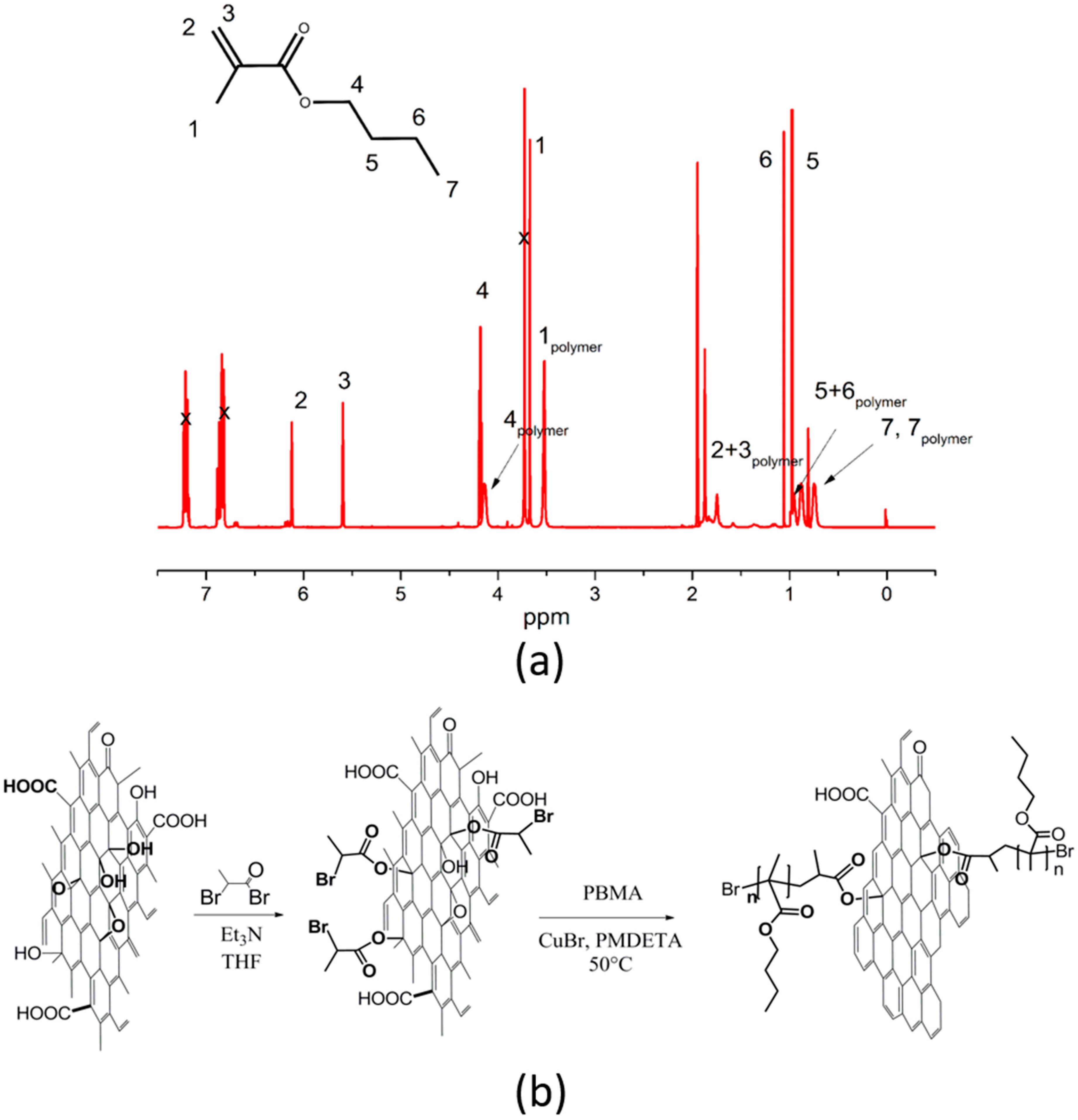
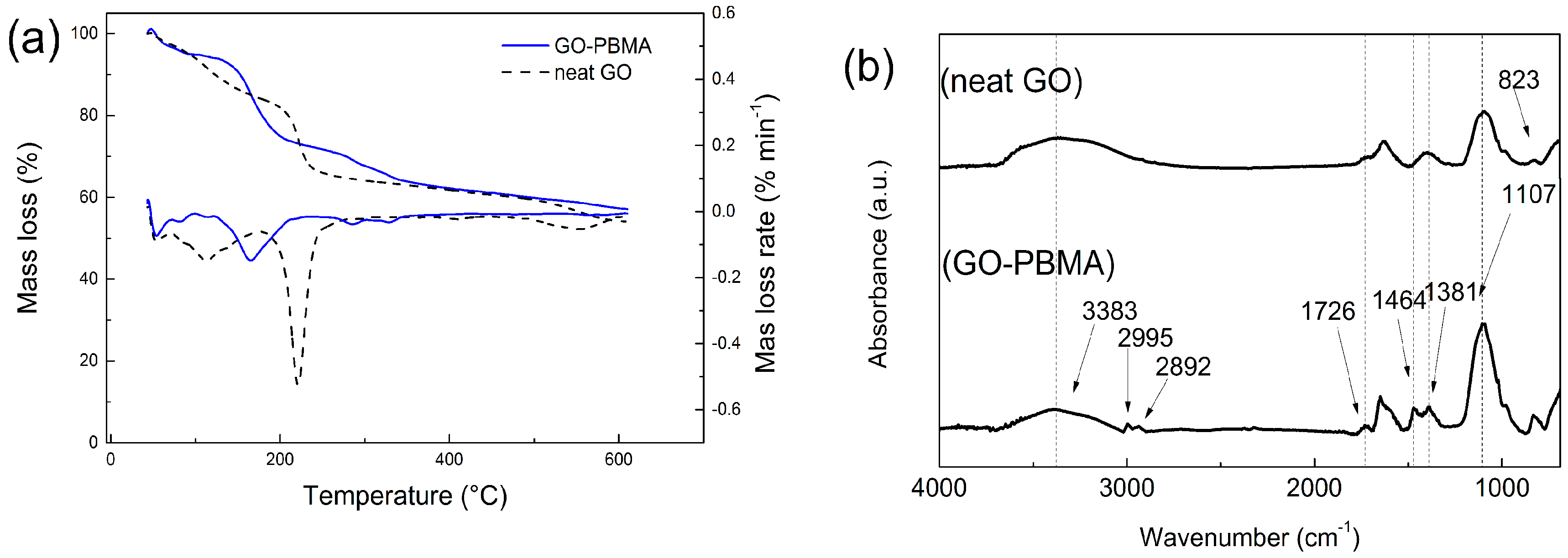
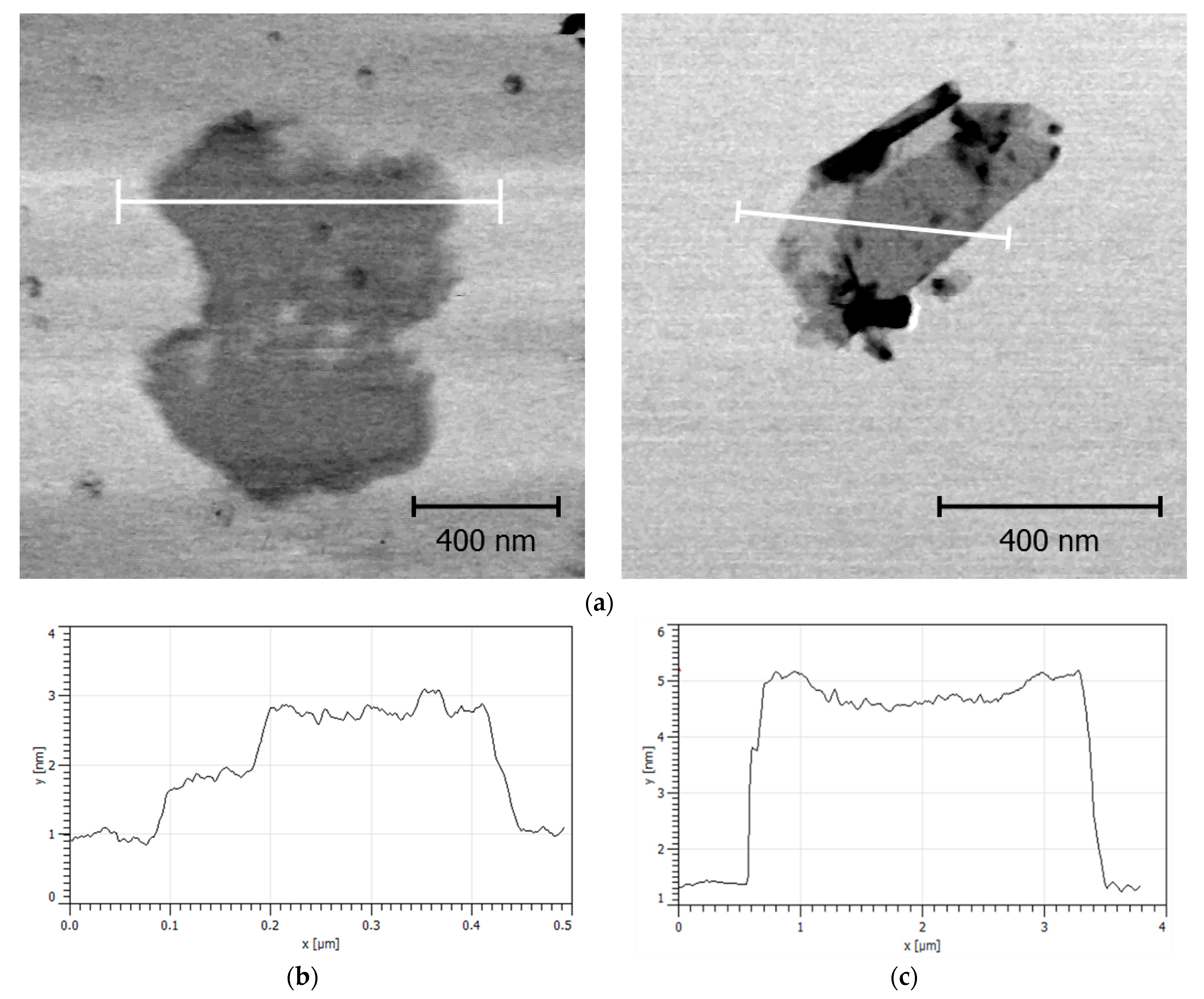

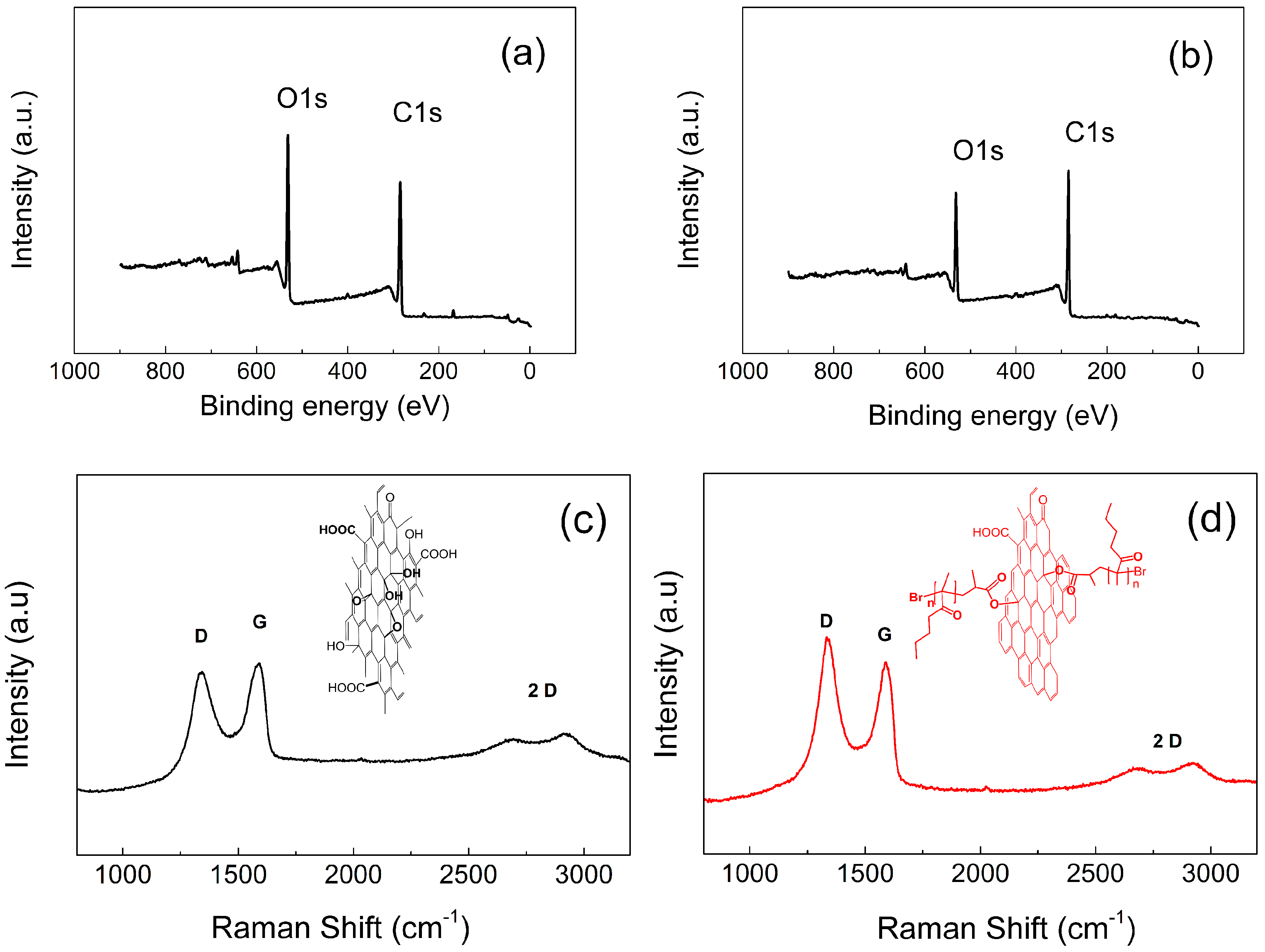
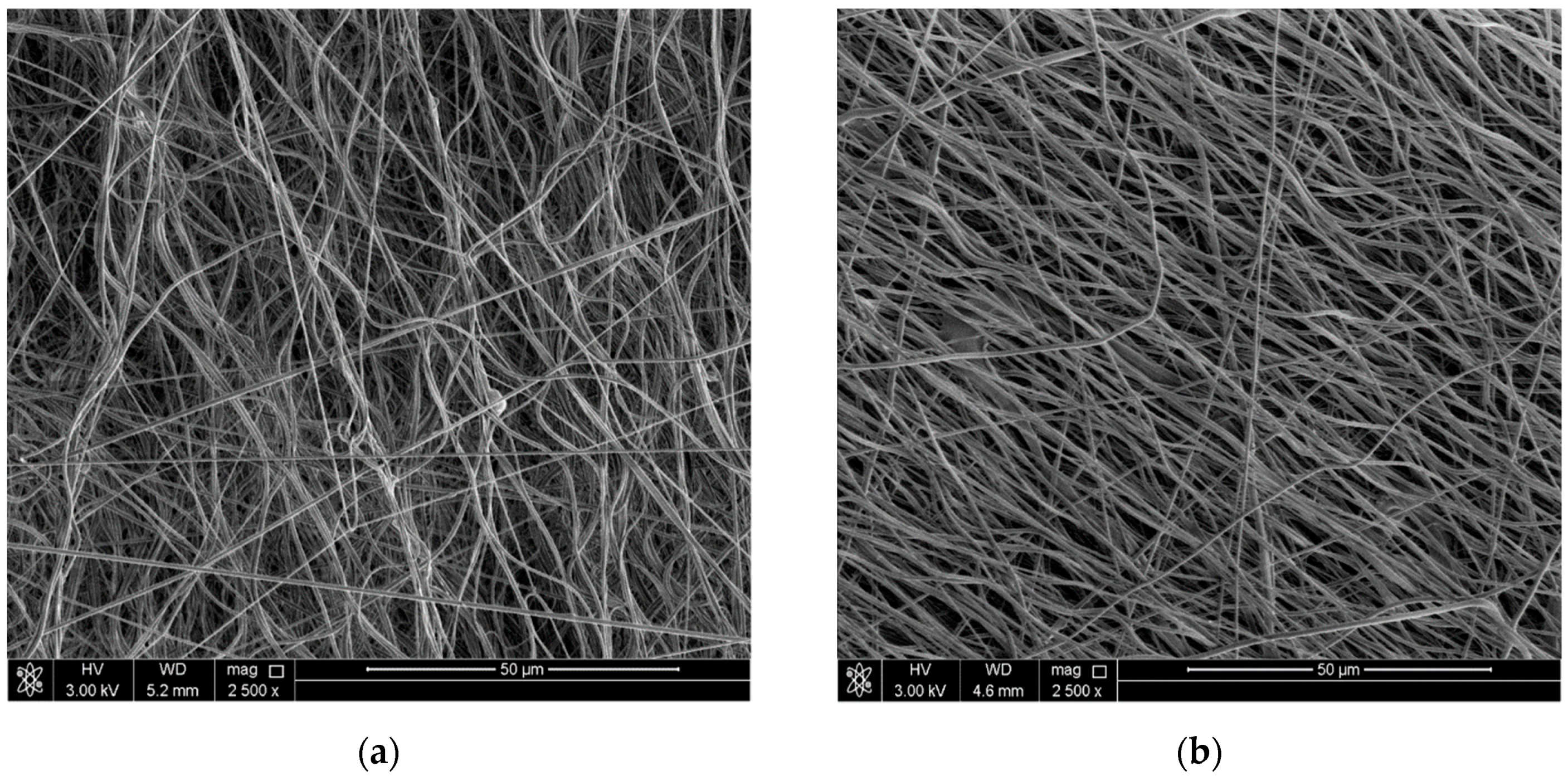
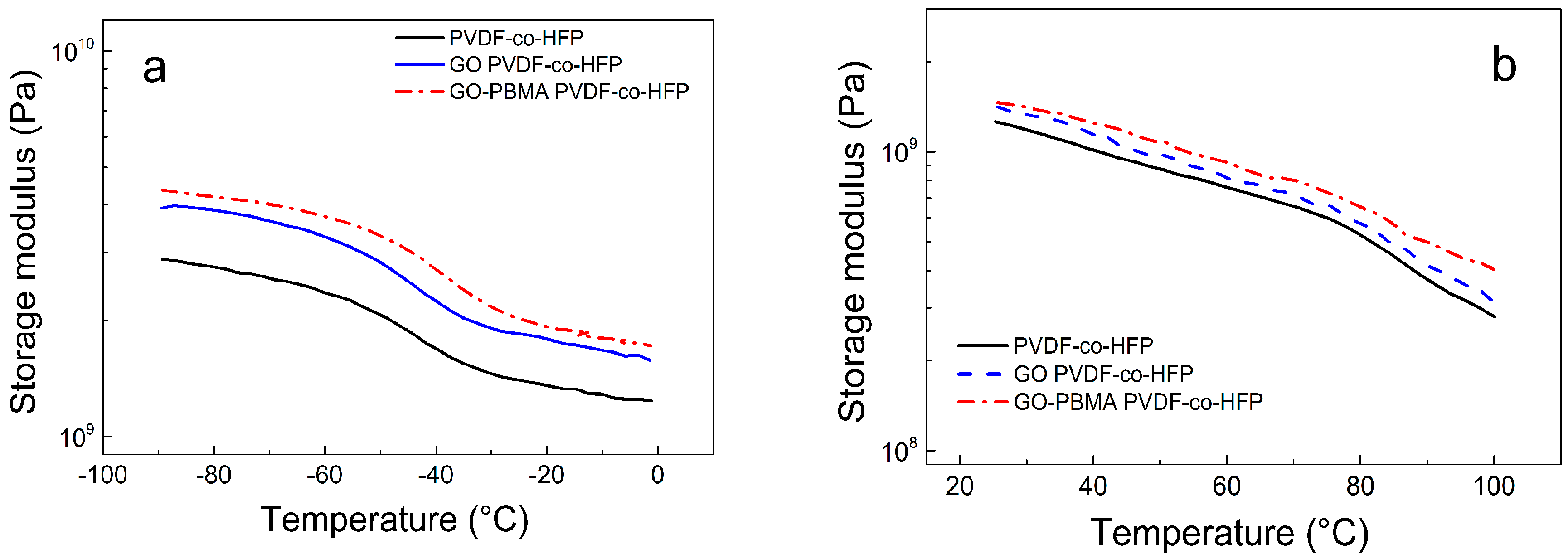
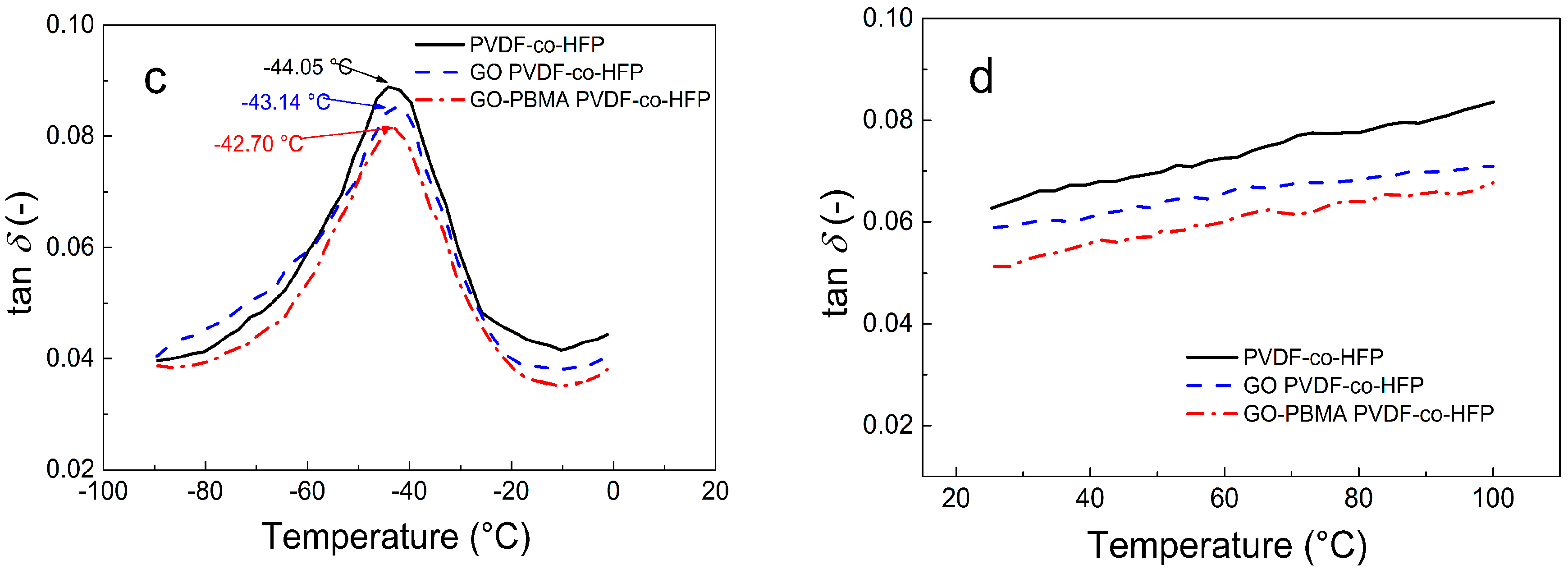

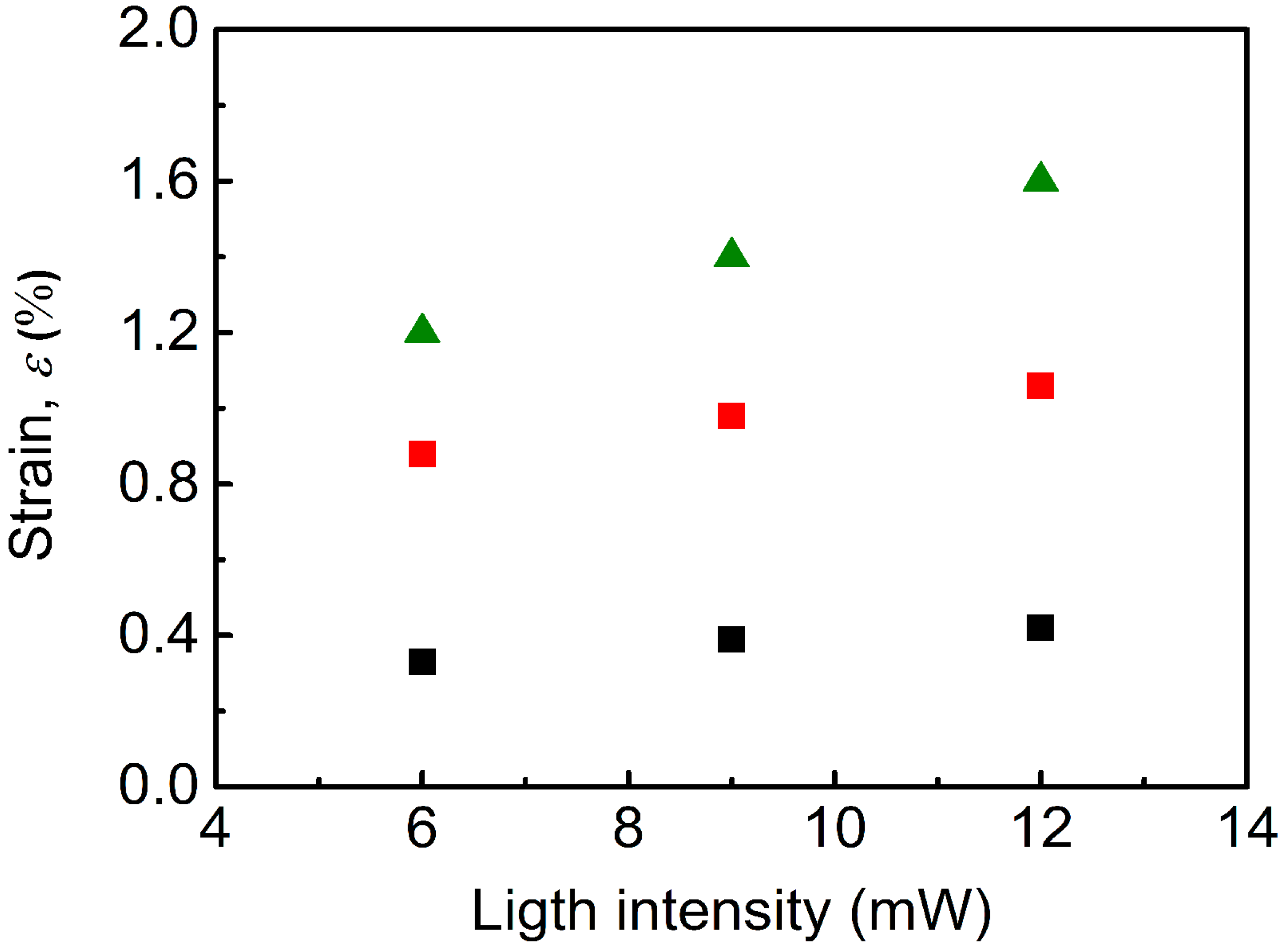
| Sample Name | C1s | O1s | C1s sp2 | C1s sp3 | C1s C–O | C1s C=O | C1s O–C=O | C1s/O1s |
|---|---|---|---|---|---|---|---|---|
| GO | 66.7 | 33.3 | 26.7 | 28.4 | 32.3 | 9.0 | 3.6 | 2.00 |
| GO-PBMA | 70.9 | 29.1 | 36.5 | 25.3 | 27.5 | 7.7 | 3.0 | 2.43 |
| Sample Name | Thermal Conductivity (W·mK−1) |
|---|---|
| PVDF-co-HFP | 0.19 |
| GO PVDF-co-HFP | 0.22 |
| GO-PBMA PVDF-co-HFP | 0.28 |
© 2019 by the authors. Licensee MDPI, Basel, Switzerland. This article is an open access article distributed under the terms and conditions of the Creative Commons Attribution (CC BY) license (http://creativecommons.org/licenses/by/4.0/).
Share and Cite
Krupa, I.; Sobolčiak, P.; Mrlik, M. Smart Non-Woven Fiber Mats with Light-Induced Sensing Capability. Nanomaterials 2020, 10, 77. https://doi.org/10.3390/nano10010077
Krupa I, Sobolčiak P, Mrlik M. Smart Non-Woven Fiber Mats with Light-Induced Sensing Capability. Nanomaterials. 2020; 10(1):77. https://doi.org/10.3390/nano10010077
Chicago/Turabian StyleKrupa, Igor, Patrik Sobolčiak, and Miroslav Mrlik. 2020. "Smart Non-Woven Fiber Mats with Light-Induced Sensing Capability" Nanomaterials 10, no. 1: 77. https://doi.org/10.3390/nano10010077
APA StyleKrupa, I., Sobolčiak, P., & Mrlik, M. (2020). Smart Non-Woven Fiber Mats with Light-Induced Sensing Capability. Nanomaterials, 10(1), 77. https://doi.org/10.3390/nano10010077




